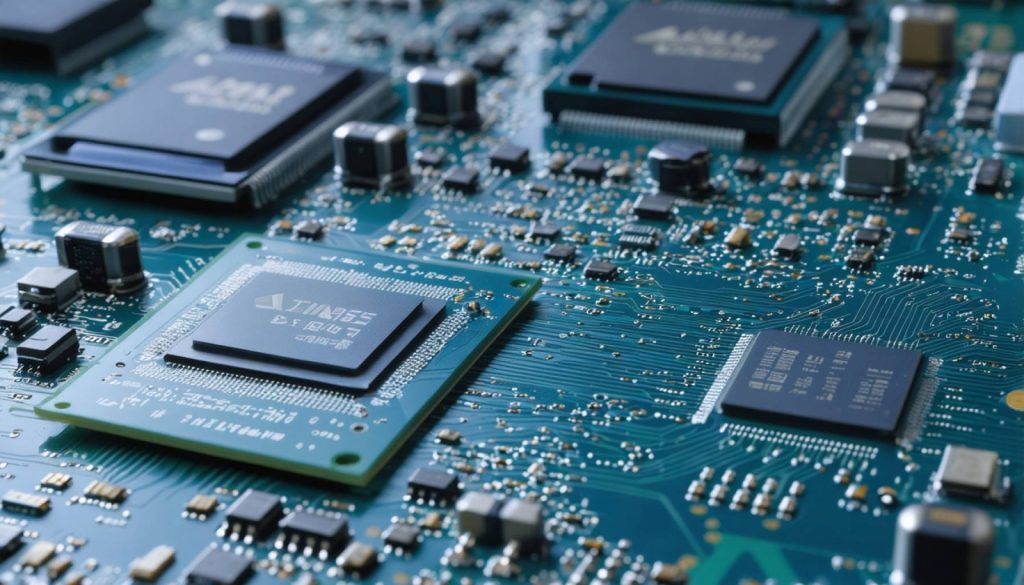
- China’s semiconductor industry is undergoing a significant transformation marked by mergers and strategic acquisitions.
- HWATSING’s acquisition of Xinyu Semiconductor signifies its intent to dominate the ion implantation equipment market.
- NAURA is increasing its stake in KINGSEMI to consolidate its influence in semiconductor production equipment.
- The SEMICON China 2025 exhibition highlighted Chinese innovations in semiconductor technology.
- China’s focus on technological autonomy is driving its domestic semiconductor industry’s rapid growth and innovation.
- Strategic acquisitions and technological breakthroughs are positioning China as a leader in the semiconductor sector.
The dynamic realm of China’s semiconductor industry is witnessing a transformative period characterized by a whirlwind of mergers and strategic acquisitions. As global tensions rise and nations emphasize technological autonomy, Chinese companies are moving swiftly to bolster their capabilities, particularly within high-end semiconductor equipment.
Exemplifying this surge, HWATSING’s recent acquisition of Xinyu Semiconductor is a bold move fueled by ambition and strategic foresight. This acquisition not only provides HWATSING with complete ownership of Xinyu but accentuates the company’s focus on penetrating deeper into the ion implantation equipment market—a core component of integrated circuit manufacturing. The acquisition, hefty in its financial outlay, is a testament to HWATSING’s commitment to enhancing its technological offerings under the robust backdrop of China’s “Equipment + Service” platform initiative.
Similarly, NAURA’s strategic maneuvers to increase its stake in KINGSEMI further underline the competitive spirit permeating the industry. By nudging its ownership to potentially become the largest shareholder, NAURA stands at the cusp of consolidating its influence in semiconductor production equipment, a crucial sector in the current technological landscape.
Amidst these corporate strategies, the SEMICON China 2025 exhibition spotlighted a burgeoning era of innovation for Chinese manufacturers. With companies like NAURA unveiling game-changing equipment such as the Sirius MC 313 ion implantation machine and HWATSING introducing advanced CMP systems, the showcase was a crystallization of years of innovation. It served as a clarion call that Chinese technological ingenuity is not merely catching up but is poised to lead in several cutting-edge domains.
The overarching narrative of China’s semiconductor landscape underscores an essential lesson in adaptability and foresight. As the geopolitical winds shift and technological demands evolve, the emphasis on strengthening domestic capabilities becomes more pronounced. The palpable momentum within the field, characterized by both strategic acquisitions and innovative breakthroughs, propels Chinese companies toward a future filled with potential and promise.
The central takeaway is clear: in the face of global competition and complex international conditions, China’s semiconductor sector is not just reacting but is aggressively setting the pace, paving the way for future technological advancements and solidifying its stance on the global stage.
The Bold Leap: How China’s Semiconductor Industry is Reshaping the Future
In-Depth Analysis of China’s Semiconductor Industry Strategy
Introduction
China’s semiconductor industry is in the throes of a transformative phase, driven by an urgent need for technological sovereignty and competitive market positioning. Recent moves involving significant mergers and acquisitions illustrate this strategic evolution. The industry’s aggressive shift towards boosting indigenous capabilities is set to redefine global semiconductor dynamics.
Understanding the Impact of HWATSING and NAURA’s Strategic Moves
1. HWATSING and Xinyu Semiconductor Acquisition
– Strategic Importance: HWATSING’s acquisition of Xinyu Semiconductor is pivotal for penetrating deeper into the ion implantation equipment market. This is critical for integrated circuit manufacturing, providing HWATSING a competitive edge.
– Financial Commitment: The substantial financial investment underscores HWATSING’s vision of technological enhancement within China’s “Equipment + Service” platform.
2. NAURA’s Stake in KINGSEMI
– Stake Increase: NAURA’s increased stake in KINGSEMI positions it to potentially become the largest shareholder, thus enhancing its influence in semiconductor production equipment.
– Strategic Positioning: This move consolidates its market presence in a crucial technology sector, vital for geopolitical and technological resilience.
Emerging Trends and Innovations Highlighted at SEMICON China 2025
The SEMICON China 2025 showcase highlighted significant advancements:
– Sirius MC 313 Ion Implantation Machine: Introduced by NAURA, this tool sets a new benchmark in semiconductor fabrication technologies.
– Advanced CMP Systems: HWATSING’s new offerings indicate leaps in innovation, aiming to lead in cutting-edge semiconductor solutions.
Industry Trends and Market Forecast
– Geopolitical Considerations: The push for domestic technological advancements is a strategic response to global tensions, ensuring China’s technological autonomy.
– Investment in R&D: Increased R&D investments are being channeled toward semiconductor innovation, projecting significant growth in local startups and technology firms.
Current Challenges and Limitations
– Security Concerns: The reliance on imported technology components poses potential security risks, prompting China to focus on self-sufficiency.
– Supply Chain Vulnerabilities: Mitigating supply chain disruptions remains a critical challenge, urging companies to develop local supply networks.
Expert Insights and Future Predictions
– Self-Sufficiency Goal: Experts predict that China’s push for self-reliance in semiconductor technologies will accelerate, reducing dependency on foreign technologies.
– Innovation Leadership: As China’s semiconductor capabilities grow, it is expected to lead in several technological domains, challenging established global players.
Actionable Recommendations
1. For Industry Players: Invest in cutting-edge R&D, focusing on sustainable and secure production practices.
2. For Policymakers: Encourage policies that support domestic innovation and international cooperation to enhance technological exchange.
3. For Investors: Look for growth opportunities in emerging semiconductor companies and technologies in China’s rapidly evolving market.
Quick Tips for Staying Updated
– Follow industry publications and major technology expos such as SEMICON China for the latest trends.
– Engage in forums and webinars hosted by industry experts to gain insights into the market’s future directions.
By understanding and leveraging these market dynamics, stakeholders in China’s semiconductor industry can better navigate the evolving landscape to foster innovation and growth. For more on China’s technological advancements, visit SEMICON China for comprehensive updates.



